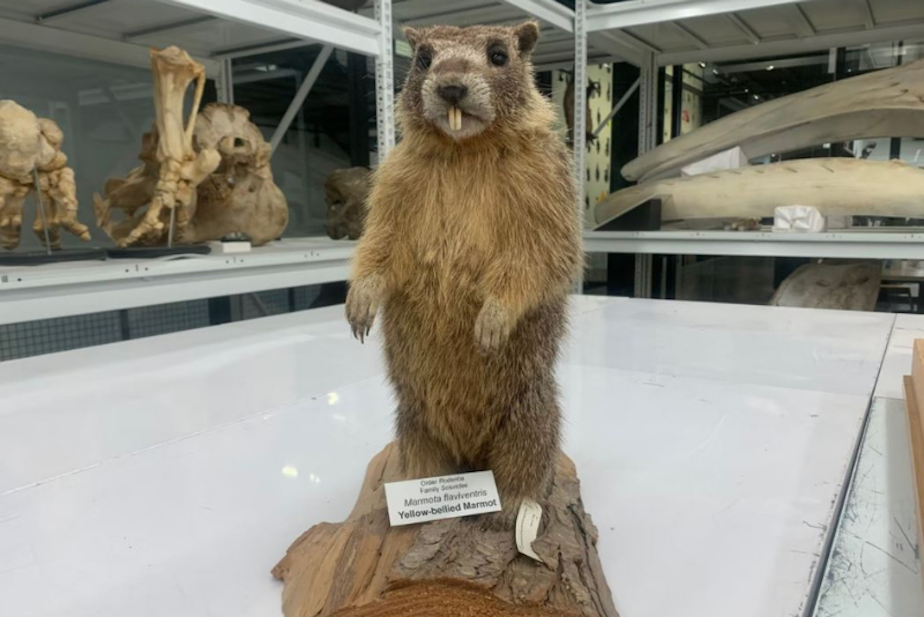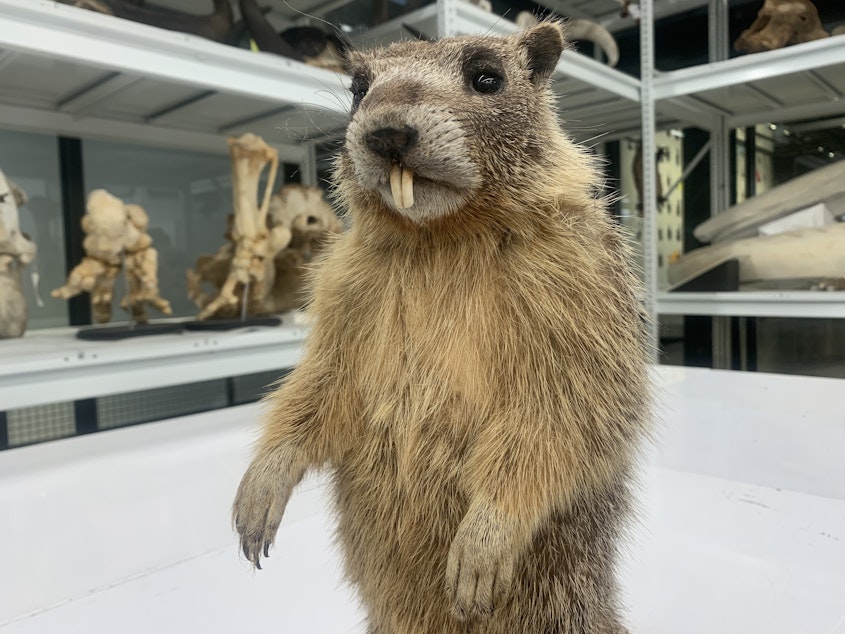How the Olympic marmot became Washington's fuzziest state symbol

Washington state is known for its variety of flora and fauna.
But there's one animal that doesn't get the same kind of love — the Olympic marmot.
Think about it — when's the last time you saw a souvenir t-shirt with a marmot on it? Orcas and salmon steal the show.
When it comes to public adoration, it seems like the Olympic marmot has been a little jilted. It's ironic, considering the fuzzy rodent was officially declared a state symbol in 2009.
But what makes the marmot so worthy of this distinction?
Jeff Bradley is the collections manager at the Burke Museum of Natural History and Culture in Seattle. To him, marmots are "beautiful."
There are three different species of marmot found in Washington: the yellow bellied marmot, the hoary marmot, and the Olympic marmot.
Sponsored
"They're basically great big ground squirrels" Bradley said.
With their brown fur, big bushy tails, and small black beady eyes, marmots also bear a striking resemblance to their cousin the groundhog.

But unlike the groundhog, Olympic marmots are exclusively found in Washington state. They can only be found in the high alpine areas and talus slopes of the Olympic Mountains.
"They're found nowhere else in the world," Bradley said. "And that's what it means to be endemic."
Sponsored
But the Olympic marmot's distinction as an endemic species to Washington state also comes with a heightened responsibility to protect them. And according to the National Park Service, Olympic marmots are vanishing from the driest meadows in the northeast Olympic Mountains.
Bradley said he's optimistic that biologists will continue to find ways to support and protect the environments where Olympic marmots live, even as our world proceeds into a future of climate change.
"The most encouraging thing about Olympic marmots is almost all of their habitat is protected within the Olympic National Park," Bradley said. "You don't have to worry about Olympic marmot habitat being developed and turned into a shopping mall."

But how did the Olympic marmot become a state symbol in the first place?
Sponsored
Essentially, it's all thanks to legislative pressure from a group of fourth graders at Wedgwood Elementary.
In 2008, fourth grade teacher Kelly Clark had just wrapped up her unit on state government, culminating in a field trip to Olympia, where students handed in their own drafted bills.
Clark said those bills would usually end up in the trash. But after the yearly field trip, she got a suggestion from a friend: Why not have her students lobby to make the marmot the state mammal?
Clark emailed former State Senator Ken Jacobsen, who was then representing the legislative district Wedgwood Elementary is in. Five minutes later, Clark heard the ping of her computer.
"I'm like, 'Oh my gosh you guys, I think we have something here because they sent it back with a bill number.'"
Sponsored
Clark tasked her students with learning as much as they could about the Olympic marmot. But at a certain point, a smaller group of students emerged as enthusiastic marmot scholars.
Gabe Briggs was one of those students.
"I wouldn't say before this I had a deep marmot passion, that would be dishonest. I was like a marmot moderate. But this bill probably pushed me into being more pro-marmot," Briggs said.
But the journey to get the marmot bill from Clark's classroom to the desk of the governor took more twists than you'd may expect.
While Briggs and his classmates were crafting posters and PowerPoints on the Olympic marmot to woo legislators in Olympia, America was in the midst of the great recession.
Sponsored
Lawmakers from both sides of the aisle argued that the state needed to focus on the financial crisis, not marmots.
Briggs is 24 now, and he sees where the adults were coming from.
"In retrospect, it's a little bit insane to be trying to pass a bill that's pretty much all ceremony during a time when these legislators should've been busy doing other stuff," he said. "I was just like, 'They should pass my marmot bill! What else goes down in Olympia? I don't really know or care to know. But I know my bill is good and they should pass it.'"
There was one lawmaker in particular who was less than enthusiastic about the marmot bill: State Representative Frank Chopp, who was then Speaker of the House.
According to Clark, Chopp was reluctant to bring the bill to the floor for a vote. So during on of the group's trips to Olympia, another representative scooped up the kids and took them to Chopp's office.
"We barged right in and said, 'Hey, we want you to put this on the floor.'" Clark said he heard them out. But in the end, "He wasn't very interested, and he didn't put it on the floor for a vote."
Their solution? Flood Chopp's email inbox.
"I wrote up what had to be written by my students. They wrote it down, went home, typed it up and sent it. They did that probably for 20, 30 days until Frank Chopp broke down and put it on the floor and it was voted in."
About a month later, the marmot bill was passed in the House. And on May 12, 2009, former Governor Christine Gregoire signed the bill, and the Olympic marmot was officially declared the state endemic mammal.
By the time it was all over, Gabe Briggs was in the fifth grade. He spent a whole year working on getting the Olympic marmot the recognition he felt it deserved. But in retrospect, he's not sure what this symbol really does for the state.
"They passed it probably because it's like a fun story. And I mean, what kind of adult votes against a bill being proposed by 10 year-olds? It took us forever to get this done. And I can only imagine how hard it is to do something that's more substantial."
But for Kelly Clark, taking the idea of making the Olympic marmot the state endemic mammal from her classroom to the Legislature was substantial.
In fact, she ranks it as the biggest achievement in her teaching career.
"I always teach them, 'You are the people these legislators are working for. Even at this age, they're working for you. You're one of their constituents and they need to listen to you,'" she said.
And, when you're emailing them every night for several weeks, Clark said, they kind of have to.






